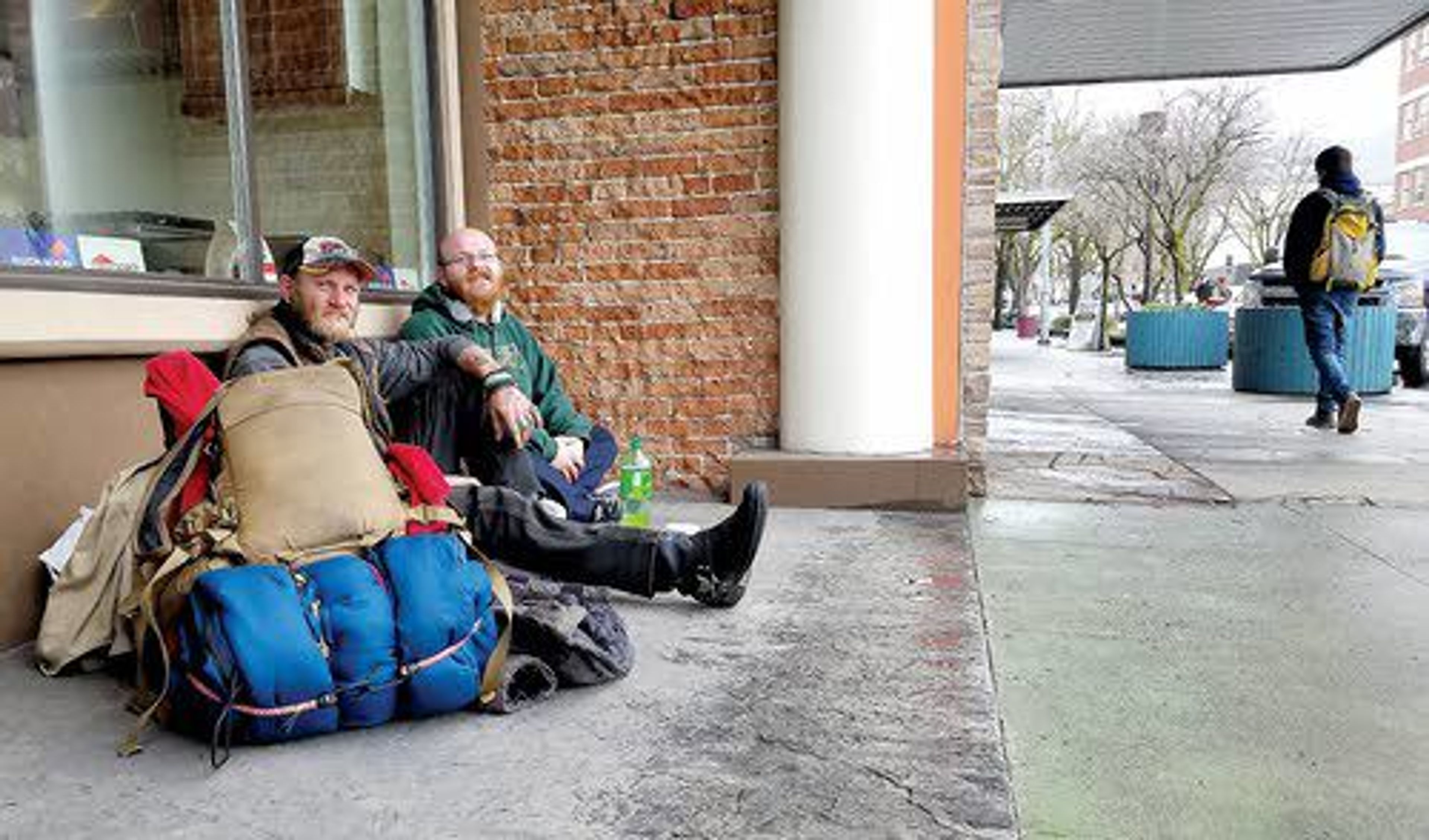No home here
The Lewiston-Clarkston Valley offers few options for the homeless
NOTE:This is part one of a two-part series examining homelessness in the Lewiston-Clarkston Valley. See Monday's Tribune for part two.
As homeless men living on the streets of Lewiston, Jeremy Sanberg and Craig Blake survive on next to nothing.
And while they are somewhat accepting of their circumstances, Sanberg and Blake do wish for something nobody has yet stepped up to provide: a place to lay their heads.
Sanberg said that could come in the form of an outdoor camp designated for use by homeless people, or a shelter that would accept them in spite of their substance abuse and mental health issues.
If the community could band together to pull off a project like a skate park, he said, it should do something to help the area's homeless population.
"There are people freezing their ass off," Sanberg said recently while plopped down with Blake in front of Largent's Appliance along Main Street to charge their phones and share smokes and Mtn Dew.
Sanberg got so desperate one icy winter night that he found an unlocked car and slept on the back seat. He has been to prison for stealing, but said he didn't take anything from the vehicle and even left a note for the owner apologizing if the interior smelled like feet.
Seeking shelters
Lewiston has no homeless shelter for men. But the ROC rescue mission in North Lewiston has plans to build one on property it owns near its 1830 Sixth Ave. N. location. ROC officials also hope to eventually add a shelter for women and children at another site on the east side of 21st Street.
The city council heard of the plans in 2016 and quickly passed a six-month moratorium on shelter construction because the city lacked any zoning code to regulate them.
Councilors enacted new zoning last year, just as the moratorium was set to expire. In general, the ordinance designated downtown and the 21st Street/Thain Road corridor for homeless shelters, as well as the city's industrial areas.
But the regulations also require anyone proposing a new shelter to obtain a conditional-use permit and have a city-approved management plan, measures that led ROC Board of Directors Chairman Gordon Gregg to question whether it would now be too onerous for the planned shelters to move forward.
Lisa Martin, chairwoman of the housing subcommittee of the Region 2 Behavioral Health Board, said establishing a men's shelter is a critical piece of dealing with the area's homeless population.
"If you keep people in a specific area, you've got more control over that," Martin said.
And shelters often serve as a contact point for all the entities that can intervene, not just in the lives of homeless people but also with any problems a shelter might bring to a neighborhood. For instance, it's easier for law enforcement to keep tabs on the residents of a shelter and for case managers to guide them toward helpful services.
"It's not easy to connect with resources when you've got mental health and other issues," Martin said. "It's monumental."
People who don't want a shelter in their neighborhood should also consider the benefits of having a centralized location for homeless services, she said, like keeping people from dispersing into the community's darker nooks and crannies seeking a place to sleep.
Money is the barrier
Some, like those at the ROC, may believe regulation makes it more difficult to start shelters, but funding is also an issue. Martin said money, not regulation, is the main barrier a community like Lewiston has to overcome.
Historically, counties have played a role in providing some form of work and shelter for homeless people. But with most local government budgets already stretched thin, Martin said significant public assistance is unlikely.
"So it really falls back onto the community," she said.
Even though he has concerns over the new regulations, Gregg said funding remains the ROC's primary barrier for its shelter projects. The board is trying to put together enough money to hire a full-time executive director who can bring a comprehensive effort to fundraising for the project, and was planning to advertise for the position in May. That has been pushed back, however, due to sluggish donations.
Nobody other than those at the ROC has even whispered about starting a homeless shelter. City of Lewiston Building Official John Smith said the Community Development Department has received exactly zero inquiries on the topic from potential developers.
Smith said if someone does come along, the city could potentially assist with an award from its federally funded Community Development Block Grant program. Such grants have to be targeted at low- and moderate-income residents, so a homeless shelter could fit that requirement, he said.
Existing buildings for sale or lease downtown have been mentioned as good shelter locations, including the shuttered Rollaway roller rink and the former Habitat For Humanity store. Both are on Idaho Street, near the Lewiston Police Department.
'We need to be humane'
Sanberg and Blake said they have become more nomadic since the ROC reduced its hours of operation last year.
"It was a place to sit and hang out for the day," Sanberg said, noting it kept him off the streets and out of trouble.
They have been spending more time in downtown Lewiston lately, or wandering the Main Street and Bridge Street corridors between Lewiston and Clarkston. Blake said downtown Lewiston is attractive because it has amenities such as the City Library with public restrooms and free Wi-Fi, and the First Step 4 Life counseling center for those with mental health and substance abuse issues.
Some downtown merchants said they haven't noticed a spike in the number of homeless people since the ROC changed its hours. But Main Street Market owner Robert Forsey said they have been a good chunk of his clientele for years, and he has definitely seen an influx over the last several months.
And while he worries that disparaging attitudes toward homelessness could hamper the ongoing success of downtown revitalization efforts, Forsey said he also has a lot of compassion and would welcome a shelter in the area.
"I think it can coexist, as long as everybody is involved," he said. "People worry that if you build it, they will come. They're already here. Ignoring them is the wrong policy. We need to be humane."
Deb Bernier, owner of Second Chance Thrift Store and Deb's Dog Grooming, said a men's shelter would complement the women's shelter at the YWCA's downtown branch.
"I don't mind," Bernier said while giving a trim to Sophie, a black Shih Tzu-Pomeranian cross. "They're people too. They have a lot to accommodate women, but not men, and that's sad."
Homeless people also lost another popular gathering spot last year when the city of Lewiston restricted public access to the Community Center on Main Street, and password-protected its Wi-Fi.
City officials said the move was in response to issues such as theft and individuals loitering inside the building all day.
Assistance is down; housing costs are up
Martin said several factors contribute to increasing homelessness in Northwest states.
Grant money the Region 2 Behavioral Health Board used for housing assistance has dried up, and homelessness is sinking its roots deeper into vulnerable populations like disabled veterans and ex-convicts.
Also, the steady increase in the cost of housing that followed the economic recovery of the last several years isn't helping matters, Martin said.
"It's just something that, as the economy continues to grow and (the cost of) housing goes up, you're going to see more people on the street."
Mills may be contacted at jmills@lmtribune.com or (208) 848-2266.
"I think it (a homeless shelter) can coexist, as long as everybody is involved. People worry that if you build it, they will come. They're already here. Ignoring them is the wrong policy. We need to be humane."
Main Street Market owner Robert Forsey











